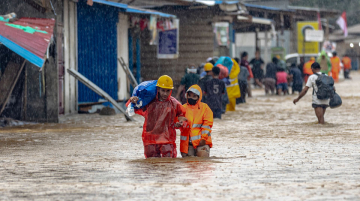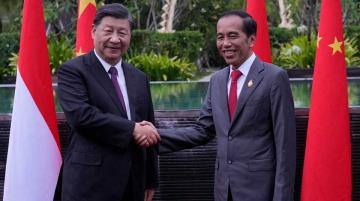
It begins with a sharp sneeze, followed by a piercing wheeze, a relentless cough, or the struggle to catch a full breath—paired with the sting of irritated eyes. In Lelilef Sawai, a small village nestled beside Weda Bay Industrial Park, a massive hub of nickel downstream processing activities on Halmahera Island, North Maluku, Indonesia, these symptoms have become so common they feel like an inescapable part of daily life.
Tomo, a lifelong resident of this tranquil North Maluku community, knows the pattern all too well. Once a fisherman, he now struggles to breathe, his lungs ravaged by what he believes to be years of exposure to industrial dust.
When the mine began operations on a large scale, the dust became overwhelming, especially during the dry season, “the dust is visible, like clouds, and when the wind from the north blow, it sweeps in from the mountains,” Tomo recounts, his voice tinged with resignation.
Despite sealing his home with high-quality materials, the dust finds its way in, coating surfaces and infiltrating lungs.
Understanding Halmahera Island and the Impact of Nickel Processing Industries to Local Communities.




Halmahera is an island located in the North Maluku province of Indonesia, part of the sprawling archipelago that stretches across Southeast Asia.
Known for its rich biodiversity and lush forests, Halmahera is now a massive hub for nickel mining and downstream operations.
Indonesia is one of the world’s top nickel producers, a metal crucial for electric vehicle (EV) batteries and renewable energy storage. With the growing demand for greener energy, Halmahera Island has become a hotspot for nickel mining, leading to a conflict between economic development and environmental conservation.
The Indonesian government’s push for mining, especially after banning raw nickel ore exports in 2014, has led to large-scale projects like the Indonesia Weda Bay Industrial Park (IWIP) on Halmahera. While these initiatives promise economic growth, they come at a significant ecological cost.
Mining has ravaged the island’s forests, endangering biodiversity and disrupting ecosystems that local communities depend on. Pollution from mines, including toxic runoff and air contamination, is polluting water sources, soil, and air—causing serious health problems for both people and wildlife.
A Clear Health Emergency




The Lelilef Health Center has been grappling with a surge in respiratory infections, a condition intricately linked to the industrial boom from nickel mining activities in the region.
Asjuati Tawinella, the center’s head, last August paints a grim picture: “According to the data I have, respiratory infection cases increased every year, ranking first annually.”
In 2018, there were 351 recorded cases; by 2022, this number had more than tripled to 1,100. The first half of 2024 continues the upward trend, with a spike to 312 in June due to the dry season and 345 in July after a major flood.
Asjuati attributes the health crisis to the booming nickel industry.
Since 2018, the Indonesia Weda Bay Industrial Park or IWIP has rapidly expanded nickel mining activities in Central Halmahera, primarily fueled by the soaring global demand for electric vehicle (EV) batteries.
While this industrial growth has brought economic opportunities, it has also unleashed a cascade of environmental and health consequences.
Breathing in Danger




Nickel smelting and coal-powered energy production release harmful gases like sulfur dioxide (SO2) and nitrogen oxides (NOx), known to irritate respiratory systems.
Additionally, mining activities generate fine particulate matter (PM10 and PM2.5), invisible yet hazardous particles that penetrate deep into the lungs.
“Yes, the mining activities are directly related to environmental issues, and the air in this area has become polluted. Now, with several active production sites, long-term impacts are inevitable,” Asjuati explained.
Vulnerable groups, such as children and the elderly, bear the brunt of the health impacts.
Tomo describes his home as being covered in thick dust during the dry season, resembling smoke. Despite closing all ventilation with high-quality materials, dust still seeps into his home. During the rainy season, Lelilef Sawai Village faces floods, while the dry season brings a storm of dust.
Tomo’s own journey underscores the human cost of this pollution. Initially misdiagnosed with acid reflux, he later discovered his lungs were deteriorating.
Now tragically dependent on “dust money”, a monthly compensation of IDR 500,000 (USD 32) from PT. IWIP for medical expenses, he finds it insufficient to cover his growing healthcare needs.
Despair
Tomo’s frustration is palpable. “We don’t have specialists here. Going to Weda is hard; from the clinic, you’re referred to Weda, then to Tobelo or Tanah Kao. A giant company like this can’t afford top-notch doctors?” he asks, highlighting the inadequate healthcare infrastructure in the area.
For many residents, the problems go beyond health. The once lush protective forests have been decimated, leading to environmental degradation.
“The current situation is due to deforestation; the protective forests are gone, so dust, soil, and water flow from the mountains. There are no trees left to hold the soil. Just a little rain now causes floods, unlike before when we had plenty of protected forests,” Tomo lamented.
As a fisherman, Tomo has stopped going to sea due to his lung condition. He now contemplates moving to Tobelo, far from his birthplace, in search of better healthcare facilities and cleaner air.
Deforestation has brought flooding during the rainy season and dust storms during the dry months, compounding the hardships. Simply a small armageddon for people living there.
Demands for Accountability and Solution




Local authorities and the government face mounting pressure to act.
Asjuati, the newly appointed chief of local health center demands stricter emission regulations and regular air quality monitoring in the the nickel hub operational areas. “(Pollution waste) should be managed to prevent its impact on the surrounding communities. Companies should pay more attention to reducing negative effects on local residents,” she urges.
There is also a need to improve healthcare access for those affected by pollution.
Community-led initiatives offer just a tiny bit of hope despite challenges. The Lelilef Health Center raises awareness on air pollution, promotes mask use and respiratory hygiene, and urges Weda Bay Industrial Park for more respiratory infection medications when government supplies are insufficient.
The road to recovery requires systemic change. Improved healthcare access, reforestation efforts, and stricter corporate accountability are critical to alleviating the burden on communities like Lelilef Sawai.
For Tomo, the choice is heart-wrenching. Unable to fish due to his health, he contemplates leaving his birthplace in search of cleaner air and better medical care. “This is my home, but living here has become unbearable,” he says.
This article can be republished under the Creative Commons BY NC ND license.







